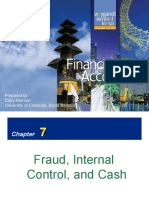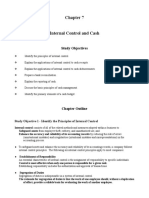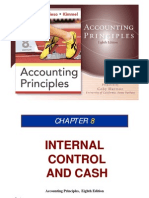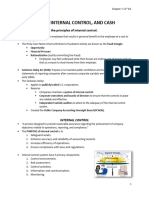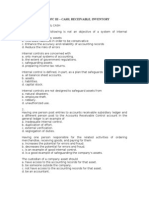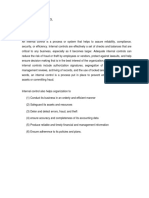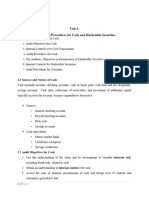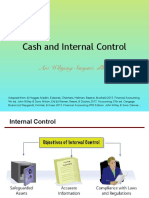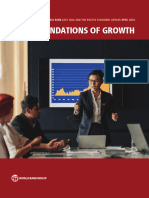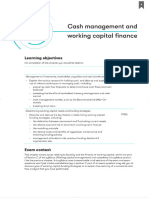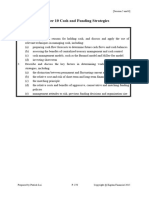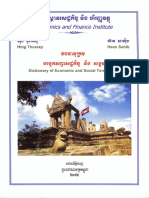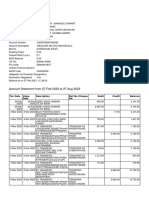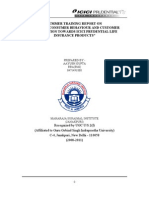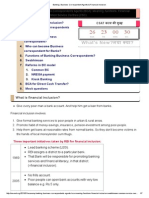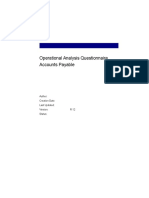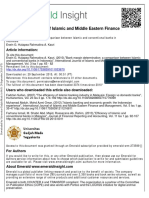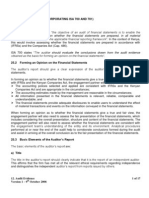15339_Weygandt_10.
qxp 12/13/07 11:09 PM Page 312
312 CHAPTER 10 Internal Control and Cash
SU M M A R Y OF STUDY OBJECTIVES
1. Define internal control. Internal control is the plan of or- include (a) having only specified individuals such as the trea-
ganization and related methods and procedures adopted surer authorized to sign checks; (b) assigning the duties of ap-
within a business to safeguard its assets and to enhance the proving items for payment, paying the items, and recording
accuracy and reliability of its accounting records. the payment to different individuals; (c) using prenumbered
2. Identify the principles of internal control. The principles checks and accounting for all checks, with each check sup-
of internal control are establishment of responsibility; segre- ported by an approved invoice; (d) storing blank checks in a
gation of duties; documentation procedures; physical, mechan- safe or vault, with access restricted to authorized personnel,
ical, and electronic controls; independent internal verification; and using a checkwriter to imprint amounts on checks; (e)
and other controls. comparing each check with the approved invoice before issu-
3. Explain the applications of internal control principles to ing the check, and making monthly reconciliations of bank and
cash receipts. Internal controls over cash receipts include (a) book balances; and (f) after payment, stamping each approved
designating only personnel such as cashiers to handle cash; (b) invoice “Paid.”
assigning the duties of receiving cash, recording cash, and cus- 5. Indicate the control features of a bank account. A bank
tody of cash to different individuals; (c) obtaining remittance account contributes to good internal control by providing
advices for mail receipts, cash register tapes for over-the- physical controls for the storage of cash. It minimizes the
counter receipts, and deposit slips for bank deposits; (d) using amount of currency that must be kept on hand, and it creates
company safes and bank vaults to store cash, with access lim- a double record of a depositor’s bank transactions.
ited to authorized personnel, and using cash registers in exe- 6. Prepare a bank reconciliation. It is customary to recon-
cuting over-the-counter receipts; (e) making independent cile the balance per books and the balance per bank to their
daily counts of register receipts and daily comparisons of to- adjusted balances. The steps in determining the reconciling
tal receipts with total deposits; and (f) bonding personnel who items are to ascertain deposits in transit,
handle cash and requiring them to take vacations. outstanding checks, errors by the depositor ✓THE
4. Explain the applications of internal control principles to or the bank, and unrecorded bank memo- NAVIGATOR
cash disbursements. Internal controls over cash disbursements randa.
GL O S S A R Y
Bank service charge A fee charged by a bank for the use of Internal control The plan of organization and all the related
its services (p. 305). methods and measures adopted within a business to safe-
Bank statement A statement received monthly from the bank guard its assets and to enhance the accuracy and reliability
that shows the depositor’s bank transactions and balances of its accounting records (p. 291).
(p. 304). NSF check A check that is not paid by a bank because of
Cash Resources that consist of coins, currency, checks, insufficient funds in a customer’s bank account (p. 305).
money orders, and money on hand or on deposit in a bank Outstanding checks Checks issued and recorded by a com-
or similar depository (p. 297). pany that have not been paid by the bank (p. 306).
Check A written order signed by the depositor directing the Segregation of duties A separation of functions or a division
bank to pay a specified sum of money to a designated recip- of work so as to provide a reliable basis of evaluating the
ient (p. 302). work of each employee (p. 292).
Deposits in transit Deposits recorded by the depositor that Voucher An authorization form prepared for each payment
have not been recorded by the bank (p. 306). by check in a voucher system (p. 301).
Electronic funds transfer (EFT) A disbursement system that Voucher system A network of approvals by authorized indi-
uses wire, telephone, telegraph, or computer to transfer cash viduals acting independently to ensure that all disbursements
from one location to another (p. 301). by check are proper (p. 300).
Internal auditors Company employees who evaluate on a
continuous basis the effectiveness of the company’s system
of internal control (p. 295).
EX E R C I S E S
Identify the internal control 10-1 Sycamore Resorts has the following internal control procedures over cash receipts. Iden-
principles applicable to cash tify the internal control principle that is applicable to each procedure.
receipts.
1. All over-the-counter receipts are registered on cash registers.
(SO 3)
�15339_Weygandt_10.qxp 12/13/07 11:09 PM Page 313
Exercises 313
2. All cashiers are bonded.
3. Daily cash counts are made by cashier department supervisors.
4. The duties of receiving cash, recording cash, and having custody of cash are assigned to
different individuals.
5. Only cashiers may operate cash registers.
10-2 George Hunting Lodge has the following internal control procedures over cash disburse- Identify the internal control
ments. Identify the internal control principle that is applicable to each procedure. principles applicable to cash
disbursements.
1. Company checks are prenumbered.
(SO 4)
2. The bank statement is reconciled monthly by an internal auditor.
3. Blank checks are stored in a safe in the treasurer’s office.
4. Only the treasurer or the assistant treasurer may sign checks.
5. Check signers are not allowed to record cash disbursement transactions.
10-3 Sue Ernesto is the owner of Ernesto’s Pizza. Ernesto’s is operated strictly on a carryout Identify the principles of
basis. Customers pick up their orders at a counter where a clerk exchanges the pizza for cash. internal control.
While at the counter, the customer can see other employees making the pizzas and the large (SO 2)
ovens in which the pizzas are baked.
Instructions
Identify the six principles of internal control, and give an example of each principle that you
might observe when picking up your pizza. (Note: It may not be possible to observe all the
principles.)
10-4 The following control procedures are used at Sandwich Company for over-the-counter Identify internal control weak-
cash receipts. nesses over cash receipts and
suggest improvements.
1. To minimize the risk of robbery, cash in excess of $100 is stored in an unlocked attaché
(SO 2, 3)
case in the stock room until it is deposited in the bank.
2. All over-the-counter receipts are registered by three clerks who use a cash register with
a single cash drawer.
3. The company accountant makes the bank deposit and then records the day’s receipts.
4. At the end of each day, the total receipts are counted by the cashier on duty and recon-
ciled to the cash register total.
5. Cashiers are experienced; they are not bonded.
Instructions
(a) For each procedure, explain the weakness in internal control, and identify the control
principle that is violated.
(b) For each weakness, suggest a change in procedure that will result in good internal
control.
10-5 The following control procedures are used in Morgan’s Fishing Excursions for cash dis- Identify internal control weak-
bursements: nesses over cash disbursements
and suggest improvements.
1. The company accountant prepares the bank reconciliation and reports any discrepancies
(SO 2, 4)
to the owner.
2. The store manager personally approves all payments before signing and issuing
checks.
3. Each week, Morgan leaves 100 company checks in an unmarked envelope on a shelf be-
hind the cash register.
4. After payment, bills are filed in a paid invoice folder.
5. The company checks are unnumbered.
Instructions
(a) For each procedure, explain the weakness in internal control, and identify the internal
control principle that is violated.
(b) For each weakness, suggest a change in the procedure that will result in good internal
control.
�15339_Weygandt_10.qxp 12/13/07 11:09 PM Page 314
314 CHAPTER 10 Internal Control and Cash
Prepare bank reconciliation 10-6 Lisa Ceja is unable to reconcile the bank balance for her catering company on January
and adjusting entries. 31. Lisa’s reconciliation is as follows:
(SO 7)
Cash balance per bank $3,660.20
Add: NSF check 590.00
Less: Bank service charge 25.00
Adjusted balance per bank $4,225.20
Cash balance per books $3,875.20
Less: Deposits in transit 530.00
Add: Outstanding checks 930.00
Adjusted balance per books $4,275.20
Instructions
(a) Prepare a correct bank reconciliation.
(b) Journalize the entries required by the reconciliation.
Determine outstanding checks. 10-7 On April 30, the bank reconciliation of Ottawa Travel shows three outstanding checks:
(SO 7) no. 254, $650; no. 255, $720; and no. 257, $410. The May bank statement and the May cash pay-
ments journal show the following:
Bank Statement Cash Payments Journal
Checks Paid Checks Issued
Date Check No. Amount Date Check No. Amount
5/4 254 650 5/2 258 159
5/2 257 410 5/5 259 275
5/17 258 159 5/10 260 790
5/12 259 275 5/15 261 500
5/20 261 500 5/22 262 750
5/29 263 480 5/24 263 480
5/30 262 750 5/29 264 560
Instructions
Using step 2 in the reconciliation procedure, list the outstanding checks on May 31.
Prepare bank reconciliation 10-8 The following information pertains to Worthy Tours:
and adjusting entries.
1. Cash balance per bank, July 31, $7,263.
(SO 7)
2. July bank service charge not recorded by the depositor $28.
3. Cash balance per books, July 31, $7,284.
4. Deposits in transit, July 31, $1,500.
5. Bank collected $800 note for Worthy in July, plus interest $36, less collection fee $20. The
collection has not been recorded by Worthy, and no interest has been accrued.
6. Outstanding checks, July 31, $691.
Instructions
(a) Prepare a bank reconciliation at July 31.
(b) Journalize the adjusting entries at July 31 on the books of Worthy Tours.
Prepare bank reconciliation 10-9 The following information relates to the Cash account in the ledger of Dick Wasson
and adjusting entries. Company:
(SO 7)
Balance September 1—$17,150; Cash deposited—$64,000
Balance September 30—$17,404; Checks written—-$63,746
�15339_Weygandt_10.qxp 12/13/07 11:09 PM Page 315
Exercises 315
The September bank statement shows a balance of $16,422 on September 30 and the following
memoranda:
Credits Debits
Collection of $1,500 note plus interest $30 $1,530 NSF check: J. E. Hoover $725
Interest earned on checking account $45 Safety deposit box rent $65
On September 30, deposits in transit were $4,150, and outstanding checks totaled $2,383.
Instructions
(a) Prepare the bank reconciliation at September 30.
(b) Prepare the adjusting entries at September 30, assuming (1) the NSF check was from a
customer on account, and (2) no interest had been accrued on the note.
10-10 The cash records of Sugar Land Country Club (SLCC) show the following four situations: Compute deposits in transit
1. The June 30 bank reconciliation indicated that deposits in transit total $920. During July and outstanding checks for
two bank reconciliations.
the general ledger account Cash shows deposits of $15,750, but the bank statement indi-
(SO 7)
cates that only $15,600 in deposits was received during the month.
2. The June, 30 bank reconciliation also reported outstanding checks of $880. During the
month of July, SLCC books show that $17,200 of checks were issued. The bank statement
showed that $16,400 of checks cleared the bank in July.
3. In September, deposits per bank statement totaled $26,700; deposits per books were
$25,400; and deposits in transit at September 30 were $2,600.
4. In September, cash disbursements per books were $23,700; checks clearing the banks were
$24,000; and outstanding checks at September 30 were $2,100.
There were no bank debit or credit memoranda. No errors were made by either the bank or
SLCC.
Instructions
Answer the following questions.
(a) In situation (1), what were the deposits in transit at July 31?
(b) In situation (2), what were the outstanding checks at July 31?
(c) In situation (3), what were the deposits in transit at August 31?
(d) In situation (4), what were the outstanding checks at August 31?
EXPLORING THE WEB
10-11 All organizations should have systems of internal control. Universities are no excep-
tion. This site discusses the basics of internal control in a university setting.
Address: www.bc.edu/offices/audit/controls
Steps: Go to the bc.edu site.
Instructions
The front page of this site provides links to pages that answer six critical questions. Use these
links to answer the following questions:
(a) In a university setting who has responsibility for evaluating the adequacy of the system
of internal control?
(b) What do reconciliations ensure in the university setting? Who should review the recon-
ciliation?
(c) What are some examples of physical controls?
(d) What are two ways to accomplish inventory counts?
ETHICS CASES
10-12 You are the assistant controller in charge of general ledger accounting at Springtime
Bottling Company. Your company has a large loan from an insurance company. The loan agree-
ment requires that the company’s cash account balance be maintained at $200,000 or more, as
reported monthly.
�15339_Weygandt_10.qxp 12/13/07 11:09 PM Page 316
316 CHAPTER 10 Internal Control and Cash
On June 30, the cash balance is $80,000, which you report to Anne Shirley, the financial
vice president. Anne excitedly instructs you to keep the cash receipts book open for one addi-
tional day for purposes of the June 30 report to the insurance company. Anne says, “If we don’t
get that cash balance over $200,000, we’ll default on our loan agreement. They could close us
down, put us all out of our jobs!” Anne continues, “I talked to Oconto Distributors (one of
Spring-time’s largest customers) this morning. They said they sent us a check for $150,000 yes-
terday. We should receive it tomorrow. If we include just that one check in our cash balance,
we’ll be in the clear. It’s in the mail!”
Instructions
(a) Who will suffer negative effects if you do not comply with Anne Shirley’s instructions?
Who will suffer if you do comply?
(b) What are the ethical considerations in this case?
(c) What alternatives do you have?
✓
■
■ Remember to go back to the Navigator box on the chapter-opening page and
check off your completed work.










